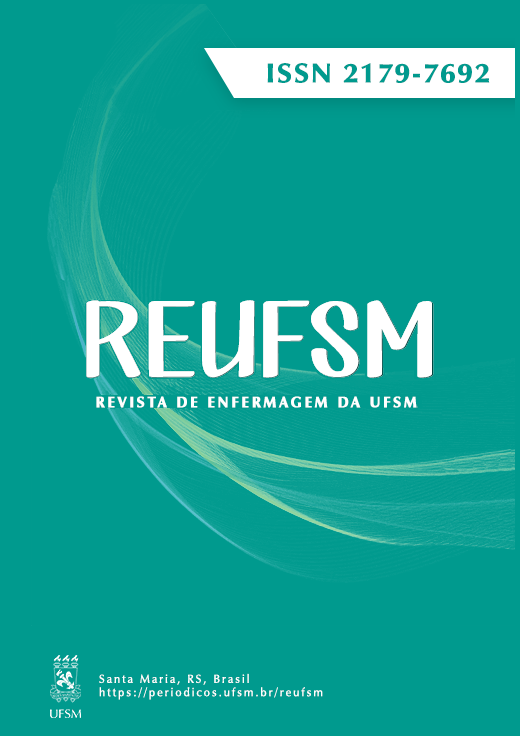Social and clinical profile of children and adolescents with type 1 diabetes mellitus
DOI:
https://doi.org/10.5902/2179769272186Keywords:
Diabetes Mellitus, Type 1, Child, Adolescent, Health Profile, Pediatric NursingAbstract
Objective: to identify the social and clinical profile of children and adolescents with type 1 diabetes mellitus. Method: quantitative, cross-sectional and descriptive research, developed with 81 guardians of children and adolescents with type 1 diabetes mellitus between March and September/2021, in two reference centers in Paraiba. The descriptive analysis was performed using the Statistical Package for the Social Science software, version 18. Results: predominantly, the companions of the children and adolescents were the mothers themselves, 90.1%, and about 40% lived with family income lower than a minimum wage. Among the children and adolescents, 54% had high glycated hemoglobin values, even though they were undergoing treatment; 65.4% indicated ignorance of the correct form of insulin storage, and 77.6% had lipohypertrophy. Conclusion: socioeconomic vulnerability and ineffective clinical management of type 1 diabetes mellitus in children and adolescents were predominant.
Downloads
References
American Diabetes Association (ADA). 14. Children and adolescents: standards of medical care in diabetes -2022. Diabetes Care. 2022;45(Suppl 1):S208-S231. doi: 10.2337/dc22-SINT
D’ Ogle G, Wang F, Gregory GA, Maniam J. Type 1 diabetes estimates in children and adults [Internet]. International Diabetes Federation Atlas Reports; 2022 [cited 2023 Jan 27]. Available from: https://diabetesatlas.org/idfawp/resource-files/2022/12/IDF-T1D-Index-Report.pdf
Souza MA, Freitas RWJF, Lima LS, Santos MA, Zanetti ML, Damasceno MMC. Qualidade de vida relacionada à saúde de adolescentes com diabetes mellitus tipo 1. Rev Latinoam Enferm. 2019;27:e3210. doi: 10.1590/1518-8345.2961.3210
Hermes TSV, Rodrigues RM, Fonseca LMM, Toso BRGO, Conterno SFR, Viera CS. Repercussões da prática educativa no autocuidado e manejo do Diabetes Mellitus tipo 1 na infância. Rev Enferm UFSM. 2021;11(50):1-21. doi: 10.5902/2179769264013
Andrade CJN, Alves CAD. Influência dos fatores socioeconômicos e psicológicos no controle glicêmico em crianças jovens com diabetes mellitus tipo 1. J Pediatr. 2019;95(1):48-53. doi: 10.1016/j.jped.2017.11.002
BRASIL. Lei no 8.069, de 13 de julho de 1990. Dispõe sobre o Estatuto da Criança e do Adolescente e dá outras providências. Brasília, DF: Presidência da República, 1990. Disponível em: http://www.planalto.gov.br/ccivil_03/LEIS/L8069.htm#art266. Acesso em: 20 ago. 2021.
Sociedade Brasileira de Diabetes (SBD). Diretrizes da Sociedade Brasileira de Diabetes (2019-2020). 2019-2020. São Paulo: AC Farmacêutica; 2019.
Santos EM, Souza VP, Correio IAG, Correio EBS. Autocuidado de usuários com diabetes mellitus: perfil sociodemográfico, clínico e terapêutico. Rev Pesqui Cuid Fundam. 2018.10(3):720-8. Disponível em: http://ciberindex.com/c/ps/P103720
Instituto Brasileiro de Geografia e Estatística (IBGE). Rendimento Domiciliar Per Capita 2021 [Internet]. Brasília (DF): IBGE; 2021 [acesso em 2022 dez 16]. Disponível em: https://ftp.ibge.gov.br/Trabalho_e_Rendimento/Pesquisa_Nacional_por_Amostra_de_Domicilios_continua/Renda_domiciliar_per_capita/Renda_domiciliar_per_capita_2021.pdf
Thomas DM, Lipsky LM, Liu A, Nansel TR. Income relates to adherence in youth with type 1 diabetes through parenting constructs. J Dev Behav Pediatr. 2018 Jul/Aug;39(6):508-15. doi: 10.1097/DBP.0000000000000579
Sutherland MW, Ma X, Reboussin BA, Mendoza JA, Bell BA, Kahkoska AR, et al. Socioeconomic position is associated with glycemic control in youth and young adults with type 1 diabetes. Pediatr Diabetes. 2020;21(8):1412-20. doi: 10.1111/pedi.13112
Souza LCVFD, Kraemer GC, Koliski A, Carreiro JE, Cat MNL, Lacerda LD, et al. Cetoacidose diabética como apresentação inicial de diabetes tipo 1 em crianças e adolescentes: estudo epidemiológico no sul do Brasil. Rev Paul Pediatr. 2020;38. doi: 10.1590/1984-0462/2020/38/2018204
Rabbone I, Schiaffini R, Cherubini V, Maffeis C, Scaramuzza A. Has COVID-19 delayed the diagnosis and worsened the presentation of type 1 diabetes in children? Diabetes Care. 2020;43(11):2870-2. doi: 10.2337/dc20-1321
Bronson SC. Letter to the Editor in response to the article “Lack of Type 1 Diabetes involvement in the SARS-CoV-2 population: Only a particular coincidence?”. Diabetes Res Clin Pract. 2020;167:108306. doi: 10.1016/j.diabres.2020.108306
Kesavadev J, Saboo B, Krishna MB, Krishnan G. Evolution of insulin delivery devices: from syringes, pens, and pumps to DIY artificial pancreas. Diabetes Ther. 2020;11(6):1251-69. doi: 10.1007/s13300-020-00831-z
Braffett BH, Gubitosi-Klug RA, Albers JW, Feldman EL, Martin CL, White NH, et al. Risk factors for diabetic peripheral neuropathy and cardiovascular autonomic neuropathy in the Diabetes Control and Complications Trial/Epidemiology of Diabetes Interventions and Complications (DCCT/EDIC) study. Diabetes. 2020;69(5):1000-10. doi: 10.2337/db19-1046
Collet N, Batista AFMB, Nóbrega VM, Souza MHN, Fernandes LTB. Autocuidado apoiado no manejo da Diabetes tipo 1 durante a transição da infância para adolescência. Rev Esc Enferm USP. 2018;52. doi: 10.1590/S1980-220X2017038503376
Singha A, Bhattacharjee R, Dalal BS, Biswas D, Choudhuri S, Chowdhury S. Associations of insulin-induced lipodystrophy in children, adolescents, and young adults with type 1 diabetes mellitus using recombinant human insulin: a cross-sectional study. J Pediatr Endocrinol Metab. 2021;34(4):503-8. doi: 10.1515/jpem-2020-0556
Silva Júnior WS, Gabbay MAL, Lamounier RN, Bertoluci M. Insulinoterapia no diabetes mellitus tipo 1 (DM1). Diretriz Oficial da Sociedade Brasileira de Diabetes; 2022. doi: 10.29327/557753.2022-5
La Banca RO, Marroni MS, Oliveira MC, Sparapani VC, Pascali PM, Oliveira SKP, et al. Técnicas de aplicação de insulina. Diretriz Oficial da Sociedade Brasileira de Diabetes, 2022. doi: 10.29327/557753.2022-4
Ministério da Saúde (BR). Estratégias para o cuidado da pessoa com doença crônica: diabetes mellitus. Brasília (DF): Ministério da Saúde, 2013. (Cadernos de Atenção Básica; 36).
Published
Versions
- 2023-11-29 (2)
- 2023-03-15 (1)
How to Cite
Issue
Section
License
Copyright (c) 2023 Revista de Enfermagem da UFSM

This work is licensed under a Creative Commons Attribution-NonCommercial-ShareAlike 4.0 International License.
This work is licensed under a Creative Commons Attribution-NonCommercial-ShareAlike 4.0 International License.








